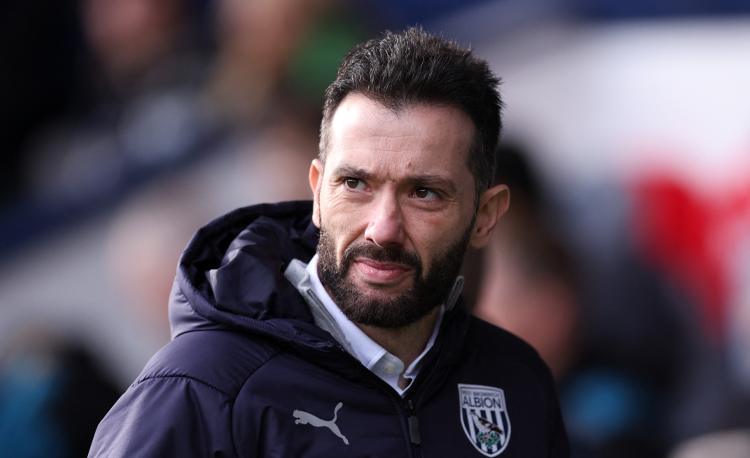Counter-pressing as an offensive weapon
This session is about the creation and application of the counter-pressing moment as an offensive weapon. It looks at recovering possession in the shortest way and time, by creating ‘hectic situations’ in the opposition formation. We want to attack the opponent non-stop when we have the ball, when we lose it and when the opposition have it.
| Area | Extended half-pitch |
| Equipment | Balls, cones, goals |
| No. of Players | Use of full squad |
| Session Time | Warm-up 10mins, Tactical rondo 20mins, Tactical game 30mins |
This session is about the creation and application of the counter-pressing moment as an offensive weapon. It looks at recovering possession in the shortest way and time, by creating ‘hectic situations’ in the opposition formation.
To this end, there are several principles that give us our identity. We want to attack the opponent non-stop when we have the ball, when we lose it and when the opposition have it. Put another way, defending is our first offensive action.
Each exercise should have this character, directly defined by our specific way of playing, where everyone is responsible for everything in the form of modern total football. In real terms, that means we have a team of 11 at a time, each of whom is an attacking forward and each of whom is a defender.
What do I get the players to do?
Tactical rondo
In a 12x12-yard area we use three teams of three playing a 6v3 possession game, as shown (1). There is no limit on touches and the team that loses the ball should react immediately, pressing the other two teams.
The closest player applies intense aggressive pressure and we defend in a triangle, while the other two players control the spaces around the ball and anticipate. In this sense, counter-pressing is the next requirement, and to be clear, this isn’t laid down as a proposal – it’s a law!
In this 6v3 tactical rondo we have set up whites and yellows against the three reds
1

2. The closest player applies intense aggressive pressure
3. His two team mates monitor and control spaces around the ball in anticipation of a pass between opponents
What are the key things to look out for?
In this exercise we want to create the right focus towards the essential part of the session. We want to create hunger towards ball recovery, creating chaotic moments and controlling these moments by being ‘quick in mind’, with orientation, skill, precision and connection. We want short intense periods alternating with rest periods so players stay fresh and alert to absorbing information and learning all the time.
The closest player goes 100% and puts total effort into the press. One player can always defend two opposition by blocking the line, pressing the ball carrier and checking over the shoulder.
The two last yards of the press define everything. As far as aggression goes – yes please! – but this must be controlled with an anticipation of where the next pass will go, and with team mates reorganising as a group constantly and quickly.
In terms of typical mistakes, we will sometimes witness disappointment after losing possession whereby players offer no immediate reaction. Development takes time – it takes time for players to make decisions based on the collective interventions and references. We don’t want a linear or mechanical state of play – a good and creative development takes time.
A high-intensity and counter-pressing team will often make more mistakes because we attempt more and perhaps accomplish more – ultimately, patience and an expectation of making mistakes is actually okay.
How do I put this into a game situation?
Using the full width of the pitch as shown (2a), and in three quarters of a pitch, one team of eight attacks a team of six. The team of six has one extra player who comes alive when they win possession. The team of eight works on their offensive organisation, their protection and the counter-pressing principle, with players chased like they have never been chased before! They do this in 3x6mins bursts, with 4mins rest in between, changing players in between the rest periods.
2a

2. Moving the ball to one side unbalances the opposition lines
3. Defenders shuffle across following the movement of the ball
4. They prepare to close down with a specific view of closing off angles and runners
To advance this, we can put two ‘sleeping’ players in, so creating better and more complex ‘protection’.
Here, the offensive organisation is to attract and then go. We want to unbalance the two lines by quick and early circulation (offensive aggression), and our players must overlap to create dangerous crossing situations, as shown (2b).
2b

2. Again (now coming back the other way), moving the ball to one side unbalances the opposition lines
3. Attackers move into any available position in bursting forward at pace
4. Quick passing creates a goalscoring opportunity
5. A goal is scored
In terms of typical mistakes, this can often come down to there being no protection, therefore the team of six can easily find the sleeping player and counter-attack and cover spaces well. Players can forget where the sleeping player is, and there is also that disappointment factor again in losing possession. Instead, we want them to react, viewing any loss of possession as an opportunity (to win it back).
Related Files
Editor's Picks
Deep runs in the final third
Using the goalkeeper in build-up play
Pressing principles
Intensive boxes drill with goals
Penetrating the final third
Creating and finishing
My philosophy
Pressing initiation
Compact team movement
Coaches' Testimonials

Alan Pardew

Arsène Wenger

Brendan Rodgers

Carlos Carvalhal

José Mourinho

Jürgen Klopp

Pep Guardiola

Roy Hodgson

Sir Alex Ferguson

Steven Gerrard
Coaches' Testimonials

Gerald Kearney, Downtown Las Vegas Soccer Club

Paul Butler, Florida, USA

Rick Shields, Springboro, USA

Tony Green, Pierrefonds Titans, Quebec, Canada
Join the world's leading coaches and managers and discover for yourself one of the best kept secrets in coaching. No other training tool on the planet is written or read by the calibre of names you’ll find in Elite Soccer.
In a recent survey 92% of subscribers said Elite Soccer makes them more confident, 89% said it makes them a more effective coach and 91% said it makes them more inspired.
Get Monthly Inspiration
All the latest techniques and approaches
Since 2010 Elite Soccer has given subscribers exclusive insight into the training ground practices of the world’s best coaches. Published in partnership with the League Managers Association we have unparalleled access to the leading lights in the English leagues, as well as a host of international managers.
Elite Soccer exclusively features sessions written by the coaches themselves. There are no observed sessions and no sessions “in the style of”, just first-hand advice delivered direct to you from the coach.









